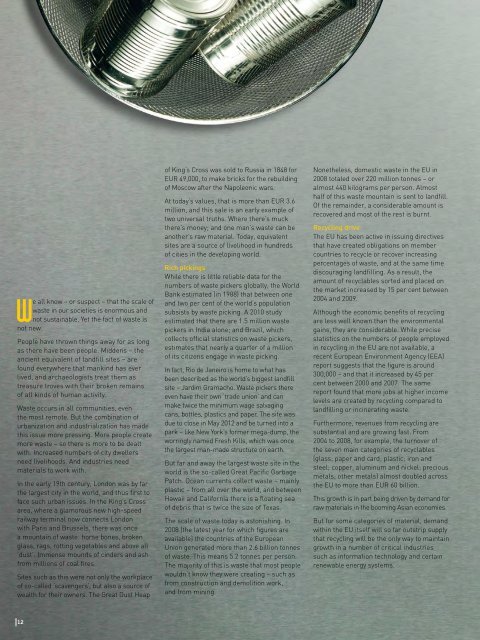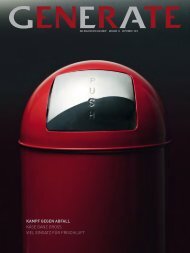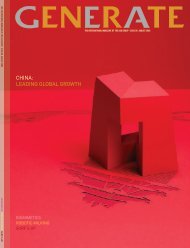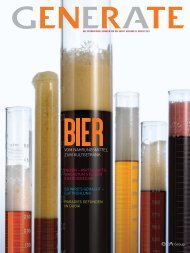A BREATH OF FRESH AIR SAY CHEESE WAR ON ... - GEA Group
A BREATH OF FRESH AIR SAY CHEESE WAR ON ... - GEA Group
A BREATH OF FRESH AIR SAY CHEESE WAR ON ... - GEA Group
Create successful ePaper yourself
Turn your PDF publications into a flip-book with our unique Google optimized e-Paper software.
e all know – or suspect – that the scale of<br />
waste in our societies is enormous and<br />
not sustainable. Yet the fact of waste is<br />
not new.<br />
People have thrown things away for as long<br />
as there have been people. Middens – the<br />
ancient equivalent of landfill sites – are<br />
found everywhere that mankind has ever<br />
lived, and archaeologists treat them as<br />
treasure troves with their broken remains<br />
of all kinds of human activity.<br />
Waste occurs in all communities, even<br />
the most remote. But the combination of<br />
urbanization and industrialization has made<br />
this issue more pressing. More people create<br />
more waste – so there is more to be dealt<br />
with. Increased numbers of city dwellers<br />
need livelihoods. And industries need<br />
materials to work with.<br />
In the early 19th century, London was by far<br />
the largest city in the world, and thus first to<br />
face such urban issues. In the King’s Cross<br />
area, where a glamorous new high-speed<br />
railway terminal now connects London<br />
with Paris and Brussels, there was once<br />
a mountain of waste: horse bones, broken<br />
glass, rags, rotting vegetables and above all<br />
‘dust’. Immense mounds of cinders and ash<br />
from millions of coal fires.<br />
Sites such as this were not only the workplace<br />
of so-called ‘scavengers’, but also a source of<br />
wealth for their owners. The Great Dust Heap<br />
12<br />
of King’s Cross was sold to Russia in 1848 for<br />
EUR 49,000, to make bricks for the rebuilding<br />
of Moscow after the Napoleonic wars.<br />
At today’s values, that is more than EUR 3.6<br />
million, and this sale is an early example of<br />
two universal truths. Where there’s muck<br />
there’s money; and one man’s waste can be<br />
another’s raw material. Today, equivalent<br />
sites are a source of livelihood in hundreds<br />
of cities in the developing world.<br />
rich pickings<br />
While there is little reliable data for the<br />
numbers of waste pickers globally, the World<br />
Bank estimated (in 1988) that between one<br />
and two per cent of the world’s population<br />
subsists by waste picking. A 2010 study<br />
estimated that there are 1.5 million waste<br />
pickers in India alone; and Brazil, which<br />
collects official statistics on waste pickers,<br />
estimates that nearly a quarter of a million<br />
of its citizens engage in waste picking.<br />
In fact, Rio de Janeiro is home to what has<br />
been described as the world’s biggest landfill<br />
site – Jardim Gramacho. Waste pickers there<br />
even have their own ‘trade union’ and can<br />
make twice the minimum wage salvaging<br />
cans, bottles, plastics and paper. The site was<br />
due to close in May 2012 and be turned into a<br />
park – like New York’s former mega-dump, the<br />
worringly named Fresh Kills, which was once<br />
the largest man-made structure on earth.<br />
But far and away the largest waste site in the<br />
world is the so-called Great Pacific Garbage<br />
Patch. Ocean currents collect waste – mainly<br />
plastic – from all over the world, and between<br />
Hawaii and California there is a floating sea<br />
of debris that is twice the size of Texas.<br />
The scale of waste today is astonishing. In<br />
2008 (the latest year for which figures are<br />
available) the countries of the European<br />
Union generated more than 2.6 billion tonnes<br />
of waste. This means 5.2 tonnes per person.<br />
The majority of this is waste that most people<br />
wouldn’t know they were creating – such as<br />
from construction and demolition work,<br />
and from mining.<br />
Nonetheless, domestic waste in the EU in<br />
2008 totaled over 220 million tonnes – or<br />
almost 440 kilograms per person. Almost<br />
half of this waste mountain is sent to landfill.<br />
Of the remainder, a considerable amount is<br />
recovered and most of the rest is burnt.<br />
recycling drive<br />
The EU has been active in issuing directives<br />
that have created obligations on member<br />
countries to recycle or recover increasing<br />
percentages of waste, and at the same time<br />
discouraging landfilling. As a result, the<br />
amount of recyclables sorted and placed on<br />
the market increased by 15 per cent between<br />
2004 and 2009.<br />
Although the economic benefits of recycling<br />
are less well known than the environmental<br />
gains, they are considerable. While precise<br />
statistics on the numbers of people employed<br />
in recycling in the EU are not available, a<br />
recent European Environment Agency (EEA)<br />
report suggests that the figure is around<br />
300,000 – and that it increased by 45 per<br />
cent between 2000 and 2007. The same<br />
report found that more jobs at higher income<br />
levels are created by recycling compared to<br />
landfilling or incinerating waste.<br />
Furthermore, revenues from recycling are<br />
substantial and are growing fast. From<br />
2004 to 2008, for example, the turnover of<br />
the seven main categories of recyclables<br />
(glass; paper and card; plastic; iron and<br />
steel; copper, aluminum and nickel; precious<br />
metals; other metals) almost doubled across<br />
the EU to more than EUR 60 billion.<br />
This growth is in part being driven by demand for<br />
raw materials in the booming Asian economies.<br />
But for some categories of material, demand<br />
within the EU itself will so far outstrip supply<br />
that recycling will be the only way to maintain<br />
growth in a number of critical industries<br />
such as information technology and certain<br />
renewable energy systems.

















